Social media is tougher than you think – at least if you’re doing it right.
It takes a lot of time and effort to develop, and then consistently implement, a solid social media strategy when there are other aspects of your business that need your attention.
The truth is that your clients, existing and potential, are spending a substantial amount of time online.
But the truth is that your clients, existing and potential, are spending a substantial amount of time online – watching, learning, engaging, purchasing, and working. And as a result, just as there’s been a shift from traditional brick-and-mortar selling to ecommerce, there’s been a shift in traditional marketing methods to digital marketing.

Consider this: 73.4 percent of social media users follow a brand because they’re interested in their products or services. In the same breath it’s important to note that 46 percent of social media users will unfollow a brand if they’re posting too many promotional messages (aka being spammy). There is a method to the madness.
There is a method to the madness.
Social media can be an excellent resource to increase brand awareness, reach new clients, and build valuable relationships with existing clients or other experts in your industry.
I’ve listed 11 actionable social media tips you can implement today, and have broken them down by the four Cs of social media: clout, community and conversations, content, and conversions. In addition, we’ll explore some valuable insight and advice from Shopify Partners who are embracing social.
Learn what to do with the traffic you drive to your site from social media in our article on how to build a clickable call to action button.
Clout
Harness the power of social to establish yourself as a trustworthy brand . Putting together a consistent and cohesive social media presence across platforms builds trust with potential clients.
. Putting together a consistent and cohesive social media presence across platforms builds trust with potential clients.
1. Implement consistent page branding
Go check your profile images on your social accounts. Are any of them fuzzy?
If you’re a web designer or developer, and you don’t have crisp, properly sized images on your social accounts, what do you think potential clients are going to assume about the quality of your work? Think of your social media profiles as a first impression.
You’ll also want to ensure you’re using consistent branding assets across channels, because consistency means reliability in the eyes of a potential client.
Consistency means reliability in the eyes of a potential client.
Make sure your logo is formatted the same, use the same color schemes, and if you can, try to use the optimum photo size when posting to each platform. If your feed contains a bunch of photos that are different sizes and qualities, it may look a little disorganized and chaotic – and you don’t want to imply that about your company.
A great example of a web agency that does this well is Pointer Creative. Whether they’re posting a job opening, a holiday picture, or a blog post, a lot of their recurring content uses consistent branding and design.
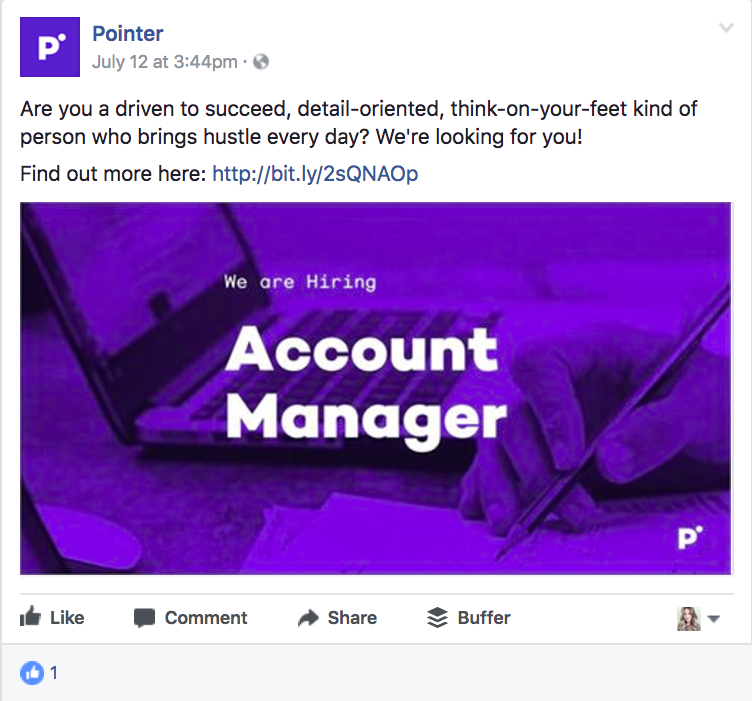

When it comes to their consistent branding and design on social, communications specialist Laura Brisson from Pointer Creative says that consistency reinforces brand identity.
“We’re professionals, but using a fun and approachable voice and showing our personality gives us the opportunity to interact on a more personal level with our audience,” Laura explains. “Second, it demonstrates to potential customers what they can expect from us when we work together. Being consistent in your own work and content goes a long way to building trust with customers.”
2. Craft profile descriptions carefully
Do not underestimate the importance of the profile section of your account. In any kind of account description or bio, you’ll want to quickly and accurately describe who you are and what you do.
In any kind of account description or bio, you’ll want to quickly and accurately describe who you are and what you do.
Your character count here is limited, so you’ll want to be careful with the words you choose. Take some time to do a bit of SEO research, with a tool like SEMrush, and see if you can implement any high-search-volume words into your description that, of course, are relevant to your business. Never sacrifice relevancy for search volume.
Theme developers Out of The Sandbox have a solid Twitter bio. They let us know what industry they’re in, mention they work specifically on Shopify theme development, and that they’re an award-winning company devoted to quality – characteristics that are likely to attract clients.
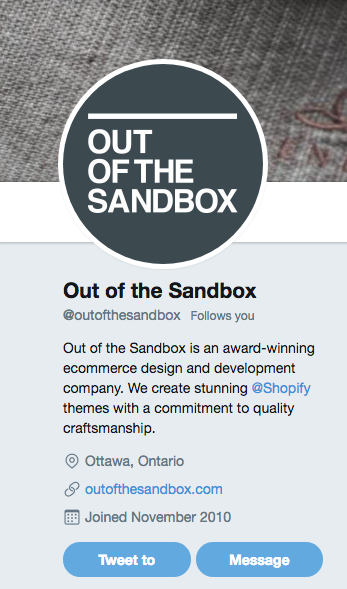
Another good example is Demac Media. They’ve incorporated a hashtag in their Twitter description to make their business more discoverable on the platform, and even add a cheeky twist to it too.
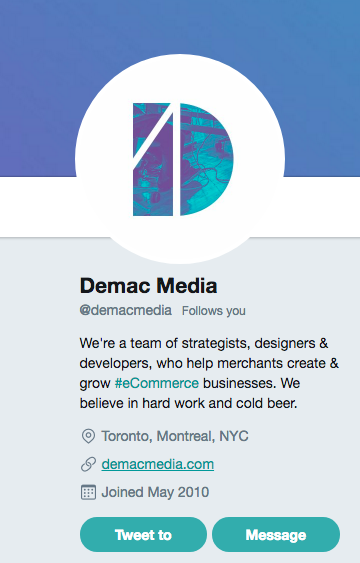
Demac Media also provides a lot of detail in their Facebook page description, including their missions statement, awards they’ve won, and more info on their story. Note that their About section is consistent with their Twitter description.
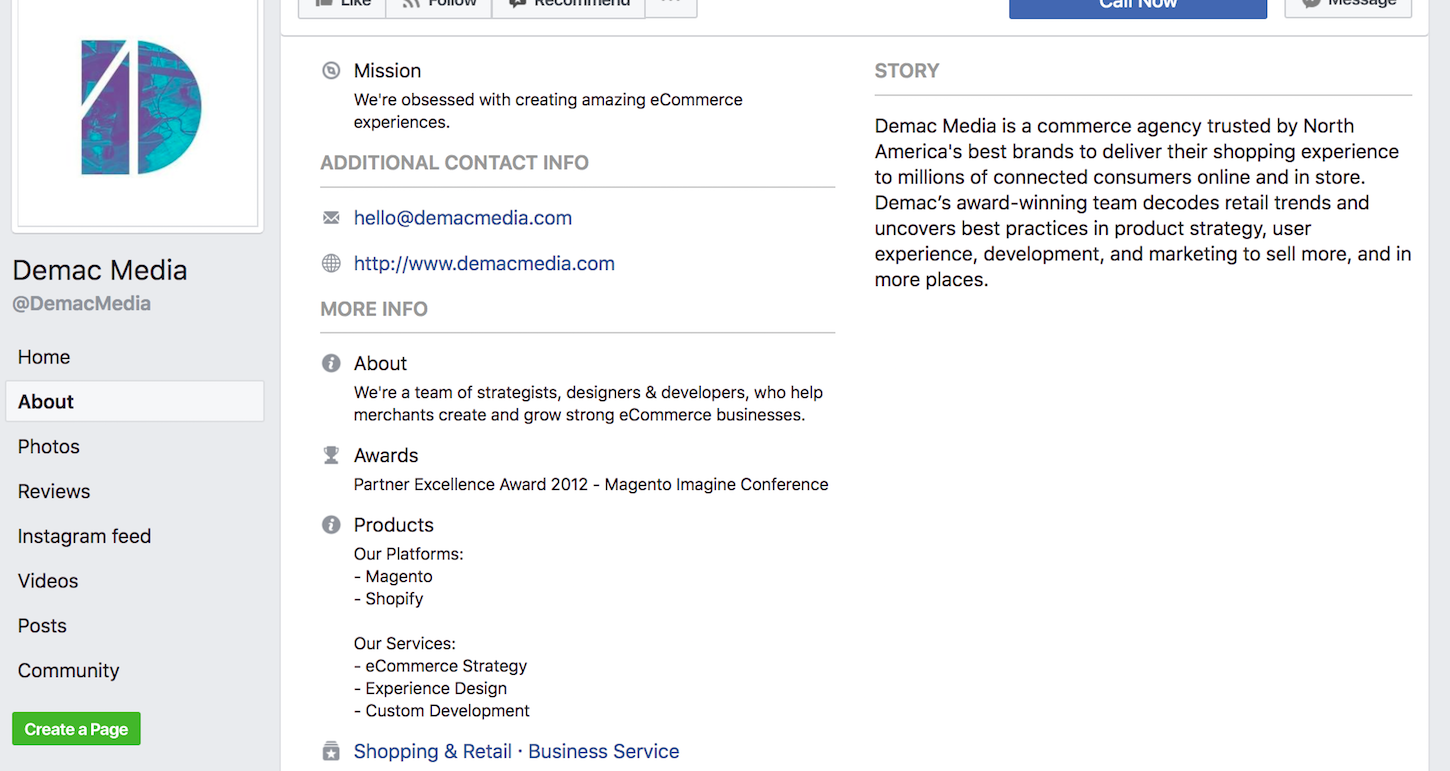
Some social platforms have larger character limits, meaning that your account’s description may be longer or more detailed. But in general, your descriptions should be similar across the board.
3. Display reviews
Imagine you’re downtown looking for a place to eat lunch, and you’re trying to decide between two restaurants. You notice that one restaurant looks busy and has quite a few people sitting outside, and the other restaurant looks empty. Which are you more likely to choose?
Many would assume that the busy restaurant must have great food and the other restaurant probably doesn’t. Although this might not actually be the reality, social proof has immense influence over consumer decisions.
Having good client reviews on your Facebook page is an excellent form of social proof. When it comes down to a potential client choosing between your business and another, you’ll want to have stellar reviews that offer more detail than a simple x-star rating, in order to convince them that you’re the best choice.
When it comes down to a potential client choosing between your business and another, you’ll want to have stellar reviews that offer more detail than a simple x-star rating.
Founder of web studio HeyCarson, Jonathan Kennedy, offers a great tactic for getting client reviews for your portfolio site, Shopify Experts profile page, or Facebook page.
“One of the most effective parts of our process, which we’ve been able to test because of the small nature of the tasks we sell, is getting the person (in our case a developer) who delivered the work to request the testimonial within hours of completing said work,” he explains.
Jonathan adds that at this point in the project timeline, customers are in a state of gratitude and are more likely to take the five minutes needed to write a review, in order to reciprocate that feeling.
He uses the following outreach (which he adjusts to fit the context of the specific project in question).
Hey [store owner name],
Thanks for choosing to work with us for your [task (or tasks)]. Would you kindly take a minute to write a short testimonial for our Expert’s profile/Facebook? It will help build our reputation as Shopify Experts, and help us reach more merchants.
Here are some basic ideas to write a good testimonials. One to three sentences is more than enough.
- Why you came to us for help or how you found us.
- What was good/great about working with our team?
- Would you come back/recommend us to other Shopify store owners?
Thanks again,
Hope to work with you again soon.
[Developer name]
The key here is to provide guidelines for the client's response, so that it’s as easy and quick as possible to complete a review.
“The sooner we send this out, the higher we convert,” Jonathan adds. “We currently get between a 20 to 25 percent response rate.”
You might also like: How To Find New Clients Using Social Media.
Community and conversations
Be active on social to tap into communities of industry experts, share advice, and connect with clients. Taking the time to listen to and engage with your community will provide you with insight, and help you establish customer relationships.
4. Use social media listening tools
Listen in on conversations. Use social media as a way to keep up with what your competition is doing and become more in tune with your clients.
One great way of doing this is creating Twitter lists or following relevant hashtags. You can create lists of competitors, accounts you draw inspiration from, or your most valued clients to see what they’re up to and what they’re currently interested in.
Keeping tabs on important people and topics in your industry can spark new online business ideas or highlight areas of improvement. You can use social media listening tools like Sprout Social, Keyhole, and Buzzlogix, to help you keep track of when keywords you’ve identified are mentioned online.
Keeping tabs on important people and topics in your industry can spark new business ideas or highlight areas of improvement.
Social media is also an avenue that many are turning to for support outreach. Public support requests can actually benefit your company, and act as a source of positive PR when handled appropriately. Take advantage of this opportunity and respond to inquiries from leads, as well as questions/concerns from clients in a friendly and timely manner.
Content Writer at Pixel Union, Alanna Mahr, says that what’s great about getting support requests over social media is that they're immediately visible to everyone in the company and to Pixel Union’s online community.
“We use a Slack integration that lets us know every time we're mentioned on Twitter, giving the whole team the opportunity weigh in with fixes, suggestions, and clarifying questions. Our marketing team of two then composes a response based on everyone’s answers.”
Teamwork makes the dream work!
5. Get involved in groups
Identify niche groups online and join them. Even if you’re not very active in them, you can still check in to keep informed and learn from your peers. But, engaging in group conversations will only add value to being a part of the group.
Do you have a burning question that you think someone in an online group would have an answer to? Post it. Do you have a solution to an issue one of your peers is having? Let them know. The more you share and support your peers, the more they will be willing to do the same for you . This cycle of feedback can help your business grow, and can save you time if you’re stumped on an issue or are experiencing a roadblock.
. This cycle of feedback can help your business grow, and can save you time if you’re stumped on an issue or are experiencing a roadblock.
The more you share and support your peers, the more they will be willing to do the same for you.
The Shopify Partners Facebook Group is an example of a hyper relevant online community that can provide you with value connections and conversations. It’s a group powered by Shopify Partners, created just for Shopify Partners. Not only are you able to discuss topics related to web design and development, you can discuss specific topics related to developing with Shopify with people in the ecosystem who are highly experienced.
You may also want to consider joining a group that includes your clients, like Shopify Entrepreneurs or Grow & Sell. It may turn out that you engage less in this group, but keeping tabs on merchant conversations could reveal common pain points they experience that you can address in future projects.
Another good point to note is that a web designer or developer working with Shopify should know the platform inside and out. A merchant-focused group would be a great opportunity for you to swing in and provide some help to a merchant struggling with the platform. Doing this every so often puts your name out into a group full of potential clients, and positions you as someone who’s experienced and able to help. You could also use a group like this as an opportunity to reach out individually to people you’re interested in working with.
Content
Establish a social presence to showcase your brand through content. Post content that’s informative, portrays your brand’s personality, and your company’s capabilities.
6. Share work samples
Use your social platforms as a medium to show off what you can do! If you’ve been working on a project that has some impressive customizations, or you’ve revamped a client’s brand let the online world know and post examples of client work that showcase your range of skills and abilities.
If you’ve been working on a project that has some impressive customizations, or you’ve revamped a client’s brand let the online world know and post examples of client work that showcase your range of skills and abilities.
Below, you can find an Instagram post that Nineteen Eighty Nine made about a new site they designed for #roadtothepodium — a charitable event supporting the next generation of Canadian Olympians.
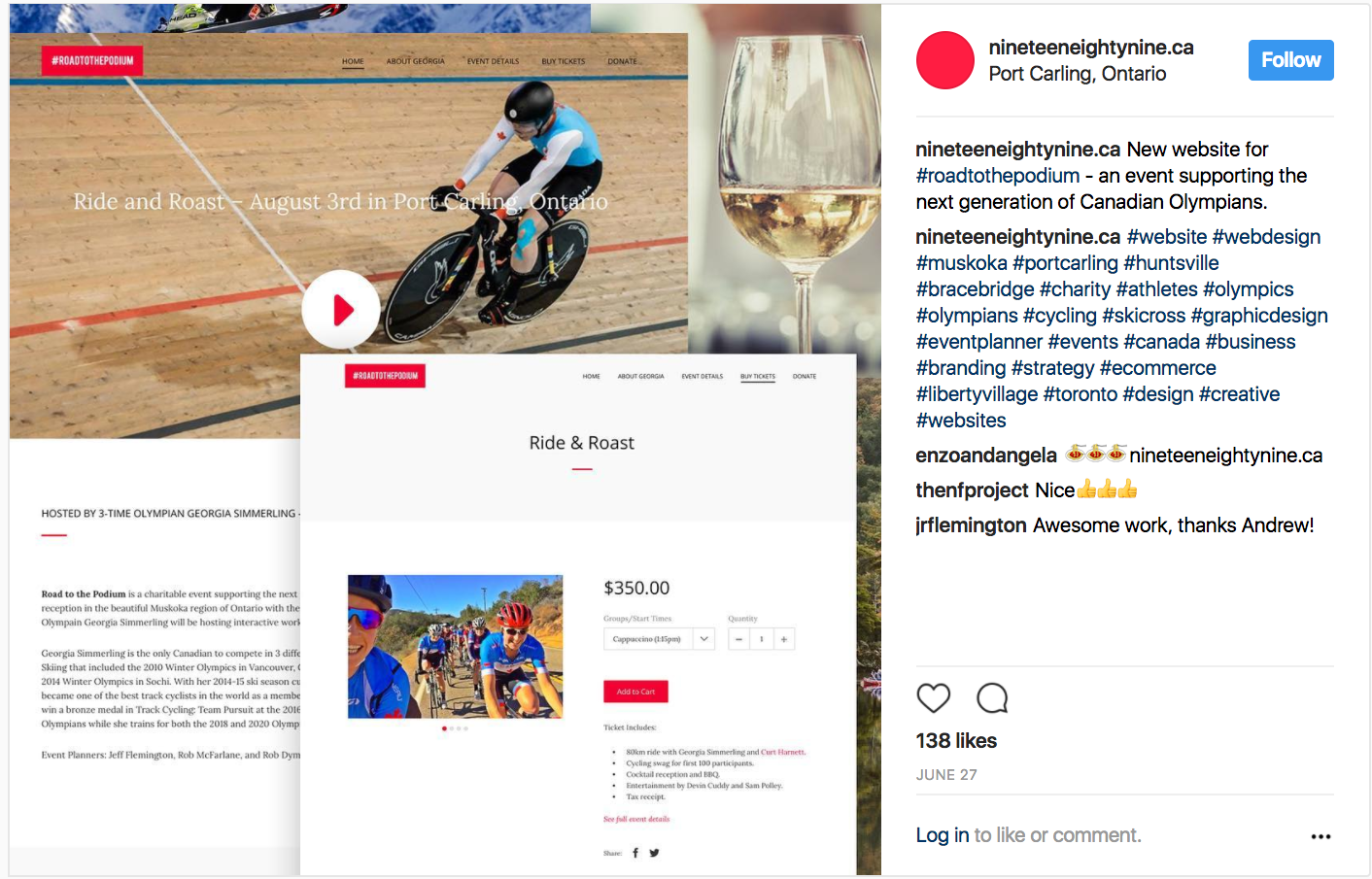
You can also see a Facebook post below that New York agency Lemonade NY sent out, showcasing a site redesign they did for a client, and American food enthusiast and model, Chrissy Teigen.

7. Get creative with your content
You work in a creative industry, so leverage that. Use custom graphics, motion graphics, and video to draw attention to your accounts and encourage people to engage with your content.
Below you can see that agency Jackpine designed a motion graphic to pair with a Christmas message, and let their followers know that they’d be away for the holidays. Rather than simply sending out a message using plain text, adding an interesting and humorous graphic, displays Jackpine’s creativity and personality.

An awesome platform to display visual design creativity on is Instagram. See how We Make Websites has visually structured their Instagram feed, alternating between photos and videos with consistent blue overlays that match the branding of their website. You’ll find that they’ve created quick videos of projects they’ve worked on to inspire others in the industry.

You might also like: 14 Agencies and Freelancers You Should Follow on Instagram.
8. Tag in third party content
Do you ever come across an interesting article relevant to your industry? A new trend, a prediction, a new update, a helpful resource, or project you thought was well executed? Share that knowledge with others and tag them.
Giving shoutouts and tagging companies in third party content gets more eyes on the post you’re sharing, and can translate into more people checking out your account. Also, acknowledging other’s good work and accomplishments can encourage other companies to tag you in their content, or to give you a kind word on social media, which is even nicer if they have a large following. In other words, be kind to your network and they’ll be kind to you.
Shopify Experts Milk Bottle Labs, based in Ireland, do this with a tweet mentioning Pixel Union.

Keith Matthews, the founder of Milk Bottle Labs, explains what value his agency gained with this tweet.
Put simply, collaboration is part of the ethos within the partner community and encouraged by Shopify.
“Ultimately the Shopify Partner Program is made of a community, which mutually assists and educates each other. In addition to benefitting other partners, it may benefit a potential Shopify customer who’s not yet on Shopify,” Keith explains. “If we all share our knowledge, everyone wins. Who knows, maybe Pixel may need an Expert in Ireland, or a client of ours may choose the theme mentioned. Put simply, collaboration is part of the ethos within the partner community and encouraged by Shopify.”
Conversions
Use social media as a way to increase your online conversions. Create social media content that links back to your SEO-rich pages, to increase the number of leads you receive.
9. Invest in social media ads
With the number of users increasing and becoming more engaged, US ad spend on social media is on pace to outgrow TV ad spend for the first time ever, and is expected to reach $35.98 billion globally in 2017.
That’s 16 percent of all digital ad spending worldwide.
Ad spend on social media is on pace to outgrow TV ad spend for the first time ever, and is expected to reach $35.98 billion globally in 2017.
However, you don’t have to have a massive budget to get results from Facebook and Instagram ads – the platforms I’d recommend advertising on, as they’re experiencing tremendous growth and consume a good chunk of a person’s average time spent on social media.
Since Instagram is owned by Facebook, the process for setting up ads on these platforms is streamlined, making it easier for you to you decide if you want to use ads on both platforms. Setting up an ad is user-friendly and Facebook provides lots of resources to help you create the most effective ads possible.
Ethercycle’s Kurt Elster describes how he’s strategically and successfully used ads on Facebook to help grow his Shopify consultancy.
“ If someone visits one of my websites, I know they're very likely interested in Shopify. By retargeting those visitors with my Shopify products and services, I’m able to inexpensively show highly relevant ads to my best audience. It's created a flywheel to grow my business. I create free, valuable content. Shopify store owners find, use, and share that content. I offer them value-added apps, info products, and services on their newsfeed. I then use that experience to create more, and more valuable content. And on it goes. It's brilliant."
10. Drive traffic by sharing original content
One of the most effective ways to drive organic traffic to your website and generate leads is to create and share original content that’s indexed on your website. One way to do this is to start blogging.
With a blog that lives on your website, each article you publish is a page that’s indexed and is an opportunity for you to rank in search engines like Google. Other examples of original content include podcasts and webinars, which you can easily embed into your blog posts.
Sometimes it can be difficult and time consuming to curate content for regular social sharing. The more original content you produce, the more content you can share on social media, ensuring you keep a consistent social presence and remain top of mind. And by regularly sharing your original content on social media, you’re leveraging and driving traffic to your own SEO-rich pages, helping you rank in search engines.

While lots of businesses run company blogs, did you know that YouTube is, in fact, the world’s second largest search engine? Creating original video content that’s optimized for SEO is also a great opportunity to rank in YouTube searches.
Something your business could do is post a clip of your YouTube video on your social channels, with a link to the full-length video. Or, you could create a short-form video fit for social media that summarizes and links to your long-form video. Below you can find an example of Shopify app developers, Bold Commerce, promoting an episode of an original educational video series with a shorter video made just for social media.

Social media specialist Mike Trakalo of Bold Commerce explains that original videos allow the company to answer common questions, and keep their app users up to date on new apps, blogs, and feature releases.
“We use social to amplify awareness and drive traffic to additional content like blog posts and app listings, so app users can make informed decisions on their own.”
Bold’s “School of Commerce” is a series of online courses designed to “help store owners take advantage the ecommerce world.”
Using a third party streaming service, attendees register for the live session and are able to ask questions in real time as the lesson goes on. The livestreamed recording is then prepped for YouTube, and the content is repackaged into blog articles. These blog articles are then packaged into short-form videos, perfect for sharing on social accounts. Social media promotion takes place, and is key, in each step of this stellar content repurposing process.
Wondering what kind of videos your agency or freelance business should make?
“Play around with video and see what you’re comfortable with. Then check the data to see what your audience likes. Then do more of that,” Mike suggests.
A few video ideas from Bold Commerce to get you started:
- Product and service announcements
- App walkthroughs
- Demos/How to videos
- Blog recaps (then direct them to the blog)
- Live Q&As
Not only does integrating video content into your social media programming add some spice to your social accounts, but video on social also tends to receive more engagement than photos.
11. Create fun contests
Contests can be used as a fun way to give back to your following, and to get people to engage with your brand. Contest formats could include:
- A “like to win contest” — A winner who likes a particular post is randomly selected.
- A “comment contest” — A winner is selected at random from those who comment (eg. “comment your favorite design tool for a chance to win *insert prize*”).
The catch with these kinds of contests is that they don’t require followers to input any of their information. Other contests, however, do require more information from participants, which can be added to your lead funnel.
Cake and Arrow recently held a contest that required participants’ contact information, and that used social media to promote it. In celebration of one year of partnership with Shopify Plus, Cake & Arrow offered a free website redesign on their platform.
The winner received:
- A free custom site redesign.
- Migration from Magento or BigCommerce to Shopify Plus.
- Free Shopify Plus licensing for six months.
Those interested had to provide their name, email, and an explanation of why they wanted their website redesigned. This contest onboards a new client (the winner), and provides a list of leads that Cake & Arrow could reach out to at a later time.
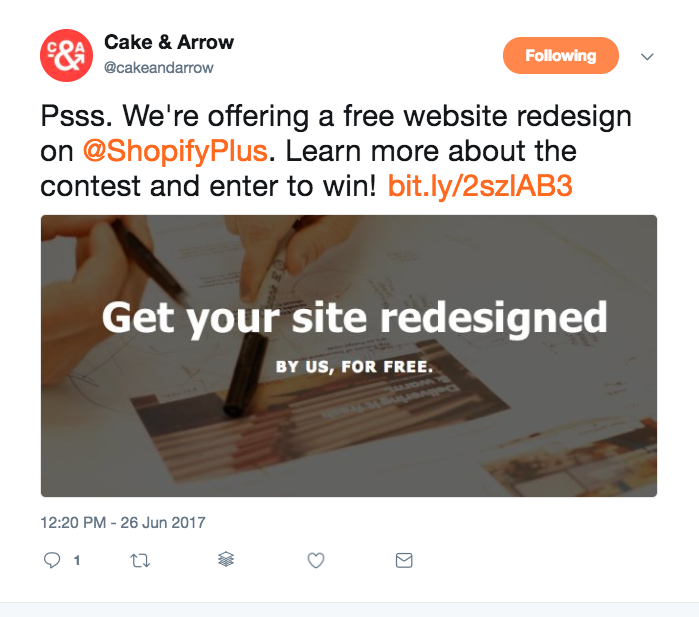
Wishpond has some ideas and tips for creating social media contests.
You might also like: 6 Social Media Services You Can Offer to Your Clients.
Implement these social media tips today
All 11 social media tips are ones that you can start using today. Don’t wait any longer — start using social media as a tool to grow your web design and development business , and establish yourself as a legitimate brand.
, and establish yourself as a legitimate brand.
Read more
- Teaching Code: A Getting Started Guide
- Free Industry Report] The Opportunities, Threats, and Future of the Consumer Electronics Industry
- Product Management Basics: Identifying Customer Pain Points and Validating Ideas
- Finding Technical Talent: Candidate Experience and Interviews
- 12 Free Tools for Remote Developers and Designers
- How to Develop an Effective Creative Brainstorming Process
- How to Build an Abandoned Cart Email Sequence
- 10 Apps to Boost Your Content Marketing Efforts
- 5 Ways to Ensure Your Client's Online Business is Tax Compliant
Do you have any social media tips that we didn’t mention? Let us know in the comments section below!

